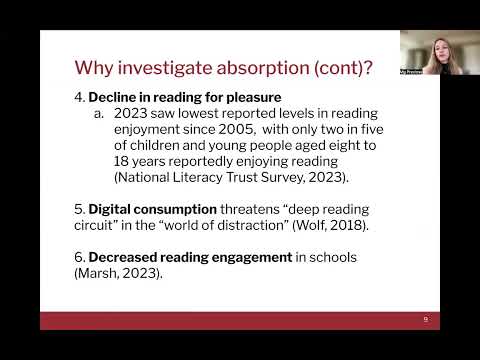 Speaker: MaryGabrielle (MG) Prezioso @mgprezioso
Speaker: MaryGabrielle (MG) Prezioso @mgprezioso
 Affiliation: Harvard University
Affiliation: Harvard University
 Co-authors: Paul L. Harris
Co-authors: Paul L. Harris
Title: Children’s Story World Absorption
Abstract: Story world absorption is a mental state in which a reader’s attention is captured by immersion in a story. This mixed-methods study investigated the mental state of story world absorption in 66 children ages 9–11 years old, asking how they experience that state. Overall, the findings underline the possibility that both frequent and occasional child readers can become absorbed in a fictional world.

 Long abstract
Long abstract
There is something remarkable that occurs when we retreat into the world of a book. The line between reality and fiction becomes blurred, the characters feel like real people, and after we finish the story, we continue to think about it, as if we lived its events firsthand – as if the narrative was a part of us.
We have all experienced this feeling, known colloquially as being “lost” in a book, and
formally as story world absorption. However, while there has been extensive research on
this phenomenon in adults, there is little research on this mental state in children. Do
children experience story world absorption? Does absorptive reading have cognitive and social-emotional benefits for children, as it does for adults?
This mixed-methods study – an adapted version of Kuijpers Story World Absorption
Scale (2014) distributed via online form, as well as a subset of qualitative, semi-structured interviews conducted in-person and over Zoom – investigated the mental state of story world absorption in 66 children ages 9–11 years old. Motivated by the hypothesis that, despite differences in their reading frequency, most children can become absorbed by stories, we asked a convenience sample of readers in the Boston area to report on their reading experience. We measured reading frequency using an adapted version of the McGeown reading engagement scale (2023). Although 9-year-old frequent readers reported greater overall absorption than 9-year-old occasional readers, 10- and 11-year-old readers reported similar levels of absorption, regardless of their reading frequency. Additionally, frequent and occasional readers across age groups were similar in the extent to which they differentially endorsed the four dimensions of the absorption experience: attention, transportation, emotional engagement, and mental imagery. Semistructured interviews conducted with a subset of the sample (18 children) provided additional information regarding the text types – narrative fiction, with a preference for mystery and fantasy literature – and features – descriptive language, fast-paced plots, and characters that are “underdogs” – that are most likely to absorb child readers.
The findings of this study underline the possibility that both frequent and occasional child readers can become absorbed in fictional worlds. It also underlines the possibility that absorption can engage occasional or disinterested readers, override differences in children’s reading habits, and cultivate certain orientations to reading, such as the expectation of joy, or willingness to persist, that are associated with reading motivation, engagement, and achievement. Continuing to investigate children’s story world absorption – in particular, to study how absorption might interface with reading engagement and motivation– two known predictors of reading achievement – might offer a new approach to supporting children’s reading comprehension and narrowing reading achievement gaps.

